Subirrigation of Container-Grown Tomato II: Physical and Chemical Properties of the Growing Medium
Abstract
:1. Introduction
2. Materials and Methods
2.1. Cultural Conditions and Plant Material
2.2. Nutrient Solutions and Irrigation Methods
2.3. Root Dry Weight and Physical and Chemical Properties
2.4. Experimental Set Up
3. Results
3.1. Root Dry Weight
3.2. Substrate Physical Properties
3.3. Substrate Chemical Properties
3.4. pH and Electrical Conductivity
3.5. Organic Acids
3.6. Relationship of Physical and Chemical Properties with Fruit Yield
4. Discussion
4.1. Substrate Physical Properties
4.2. Substrate Chemical Properties
4.3. Organic Acids
5. Conclusions
Author Contributions
Funding
Acknowledgments
Conflicts of Interest
References
- García-Santiago, J.C.; Valdez-Aguilar, L.A.; Cartmill, A.D.; Cartmill, D.L.; Juárez-López, P.; Díaz-Pérez, J.C. Subirrigation of Container-Grown Tomato I: Decreased concentration of the nutrient solution sustains growth and yield. Water 2019, 11, 2064. [Google Scholar] [CrossRef]
- Fonteno, W.C.; Cassel, D.K.; Larson, R.A. Physical properties of three container media and their effect on poinsettia growth. J. Am. Soc. Hort. Sci. 1981, 106, 736–741. [Google Scholar]
- Martinetti, L.; Ferrante, A.; Quattrini, E. Effect of drip or subirrigation on growth and yield of Solanum melongena L. in closed systems with salty water. Res. J. Biol. Sci. 2008, 3, 467–474. [Google Scholar]
- Rouphael, Y.; Cardarelli, M.; Rea, E.; Colla, G. The influence of irrigation system and nutrient solution concentration on potted geranium production under various conditions of radiation and temperature. Sci. Hort. 2008, 118, 328–337. [Google Scholar] [CrossRef]
- Santamaria, P.; Campanile, G.; Parente, A.; Elia, A. Subirrigation vs. drip-irrigation: Effects on yield and quality of soilless grown cherry tomato. J. Hort. Sci. Biotechnol. 2003, 78, 290–296. [Google Scholar] [CrossRef]
- Reed, D.W. Closed production systems for containerized crops: Recirculating subirrigation and zero-leach system. In Water, Media and Nutrition for Greenhouse Crops; Reed, D.W., Ed.; Ball Publishing: Batavia, IL, USA, 1996; pp. 221–245. [Google Scholar]
- Bouchaaba, Z.; Santamaria, P.; Choukr-Allah, R.; Lamaddalena, N.; Montesano, F.F. Open-cycle drip vs. closed-cycle subirrigation: Effects on growth and yield of greenhouse soilless green bean. Sci. Hort. 2015, 182, 77–85. [Google Scholar] [CrossRef]
- Biernbaum, J.A. Are you ready for subirrigation? Am. Veg. Grower 1990, 38, 44–45. [Google Scholar]
- Biernbaum, J.A. Get ready for subirrigation. Greenh. Grow. 1990, 8, 130–133. [Google Scholar]
- Biernbaum, J.A. Root-zone management of greenhouse container-grown crops to control water and fertilizer use. HortTechnology 1992, 2, 127–132. [Google Scholar] [CrossRef]
- Steiner, A.A. A universal method for preparing nutrient solutions of a certain desired composition. Plant Soil 1961, 15, 134–154. [Google Scholar] [CrossRef] [Green Version]
- de Boodt, M.; Verdonck, O.; Cappaert, I. Method for measuring the water release curve of organic substrates. Acta Hort. 1974, 37, 2054–2062. [Google Scholar] [CrossRef]
- de Boodt, M.; Verdonck, O. The physical properties of the substrates in horticulture. Acta Hort. 1972, 26, 37–44. [Google Scholar] [CrossRef]
- Bilderback, T.E.; Fonteno, W.C.; Johnson, D.R. Physical properties of media composed of peanut hulls, pine bark, and peatmoss and their effects on azalea growth. J. Am. Soc. Hort. Sci. 1982, 107, 522–525. [Google Scholar]
- Bremner, J.M. Total nitrogen. In Methods of Soil Analysis. Part 3. Chemical Methods; Sparks, D.L., Ed.; Soil Science Society of America: Madison, WI, USA, 1996; pp. 1085–1086. [Google Scholar]
- Murphy, J.; Riley, J.P. A modified single solution method for the determination of phosphate in natural waters. Anal. Chim. Acta 1962, 27, 31–36. [Google Scholar] [CrossRef]
- Santamaria, P.; Serio, F. Coltivazione a ciclo chiuso: La subirrigazione in canaletta. Inf. Agrar. 2001, 57, 45–49. [Google Scholar]
- Argo, W.R.; Biernbaum, J.A. The effect of irrigation method, water-soluble fertilization, preplant nutrient charge, and surface evaporation on early vegetative and root growth of poinsettia. J. Am. Soc. Hort. Sci. 1995, 120, 63–169. [Google Scholar] [CrossRef]
- Zheng, Y.; Graham, T.; Richard, S.; Dixon, M. Potted gerbera production in a subirrigation system using low-concentration nutrient solutions. HortScience 2004, 39, 1283–1286. [Google Scholar] [CrossRef]
- Kent, M.W.; Reed, D.W. Nitrogen nutrition of New Guinea impatiens “Barbados” and spathiphyllum “Petite” in a subirrigation system. J. Am. Soc. Hort. Sci. 1996, 121, 816–819. [Google Scholar] [CrossRef]
- Rouphael, Y.; Colla, G. Growth, yield, fruit quality and nutrient uptake of hydroponically cultivated zucchini squash as affected by irrigation systems and growing seasons. Sci. Hort. 2005, 105, 177–195. [Google Scholar] [CrossRef]
- Rouphael, Y.; Colla, G. The influence of drip irrigation or subirrigation on zucchini squash grown in closed-loop substrate culture with high and low nutrient solution concentrations. HortScience 2009, 44, 306–311. [Google Scholar] [CrossRef]
- van Iersel, M.W. Post-production leaching affects the growing medium and respiration of subirrigated poinsettias. HortScience 2000, 35, 250–253. [Google Scholar] [CrossRef]
- Incrocci, L.; Malorgio, F.; Della Bartola, A.; Pardossi, A. The influence of drip irrigation or subirrigation on tomato grown in closed loop substrate culture with saline water. Sci. Hort. 2006, 107, 365–372. [Google Scholar] [CrossRef]
- Cox, D.A. Growth, nutrient content, and growth medium electrical conductivity of poinsettia irrigated by subirrigation or from overhead. J. Plant Nutr. 2001, 24, 523–533. [Google Scholar] [CrossRef]
- Kang, J.G.; van Iersel, M.W. Interactions between temperature and fertilizer concentration affect growth of subirrigated petunias. J. Plant Nutr. 2001, 24, 753–765. [Google Scholar] [CrossRef]
- Pinto, J.R.; Chandler, R.A.; Dumroese, R.K. Growth, nitrogen use efficiency, and leachate comparison of subirrigated and overhead irrigated pale purple coneflower seedlings. HortScience 2008, 43, 897–901. [Google Scholar] [CrossRef]
- Montesano, F.; Parente, A.; Santamaria, P. Closed cycle subirrigation with low concentration nutrient solution can be used for soilless tomato production in saline conditions. Sci. Hort. 2010, 124, 338–344. [Google Scholar] [CrossRef]
- Liu, J.; Leatherwood, W.R.; Mattson, N.S. Irrigation method and fertilizer concentration differentially alter growth of vegetable transplants. HortTechnology 2012, 22, 56–63. [Google Scholar] [CrossRef]
- Morvant, J.K.; Dole, J.M.; Allen, A. Irrigation systems alter distribution of roots, soluble salts, nitrogen and pH in the root medium. HortTechnology 1997, 7, 156–160. [Google Scholar] [CrossRef]
- Klock-Moore, K.A.; Broschat, T.K. Use of subirrigation to reduce fertilizer runoff. Proc. Fla. State Hort. Soc. 2000, 113, 149–151. [Google Scholar]
- Davis, A.S.; Aghai, M.M.; Pinto, J.R.; Apostol, K.G. Growth, gas exchange, foliar nitrogen content, and water use of subirrigated and overhead-irrigated Populus tremuloides Michx. seedlings. HortScience 2011, 46, 12491253. [Google Scholar] [CrossRef]
- Abbas, G.; Saqib, M.; Akhtar, J.; Murtaza, G.; Shahid, M. Effect of salinity on rhizosphere acidification and antioxidant activity of two acacia species. Can. J. For. Res. 2014, 45, 124–129. [Google Scholar] [CrossRef]
- Chen, J.H.; Lin, Y.H. Sodium chloride causes variation in organic acids and proteins in tomato root. Afr. J. Biotechnol. 2010, 9, 8161–8167. [Google Scholar] [Green Version]
- Larsen, P.B.; Degenhardt, J.; Tai, C.Y.; Stenzler, L.M.; Howell, S.H.; Kochain, L.V. Aluminum-resistant arabidopsis mutants that exhibit altered patterns of aluminum accumulation and organic acid release from roots. Plant Physiol. 1998, 117, 9–18. [Google Scholar] [CrossRef] [PubMed]
- Rougier, M. Secretory activity at the root cap. In Encyclopedia of Plant Physiology; New Series Plant Carbohydrates II; Tanner, W., Loews, F.A., Eds.; Springer: Berlin, Germany, 1981; Volume 13B, pp. 542–574. [Google Scholar]
- Nardi, S.; Concheri, G.; Pizzeghello, D.; Sturaro, A.; Rella, R.; Parvoli, G. Soil organic matter mobilization by root exudates. Chemosphere 2000, 5, 653–658. [Google Scholar] [CrossRef]
- Guo, L.Q.; Shi, D.C.; Wang, D.L. The key physiological response to alkali stress by the alkali-resistant halophyte Puccinellia tenuiflora is the accumulation of large quantities of organic acids and into the rhyzosphere. J. Agron. Crop. Sci. 2010, 196, 123–135. [Google Scholar] [CrossRef]
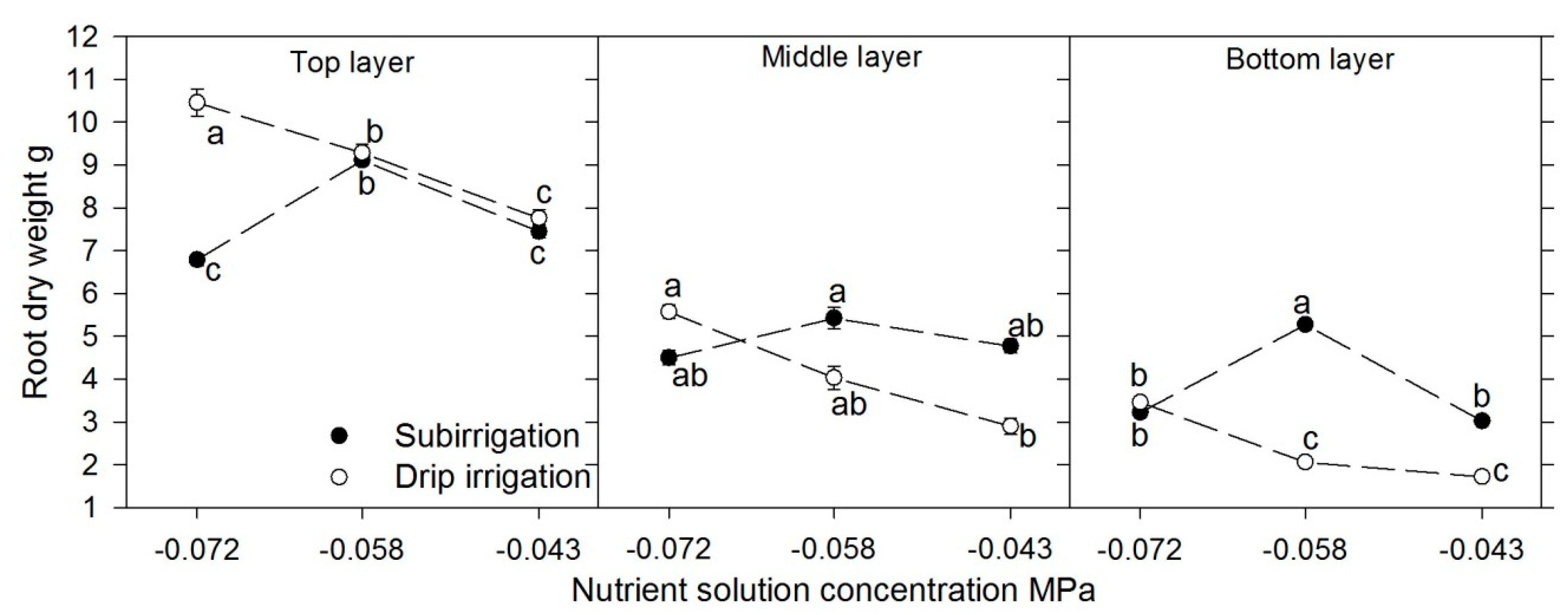
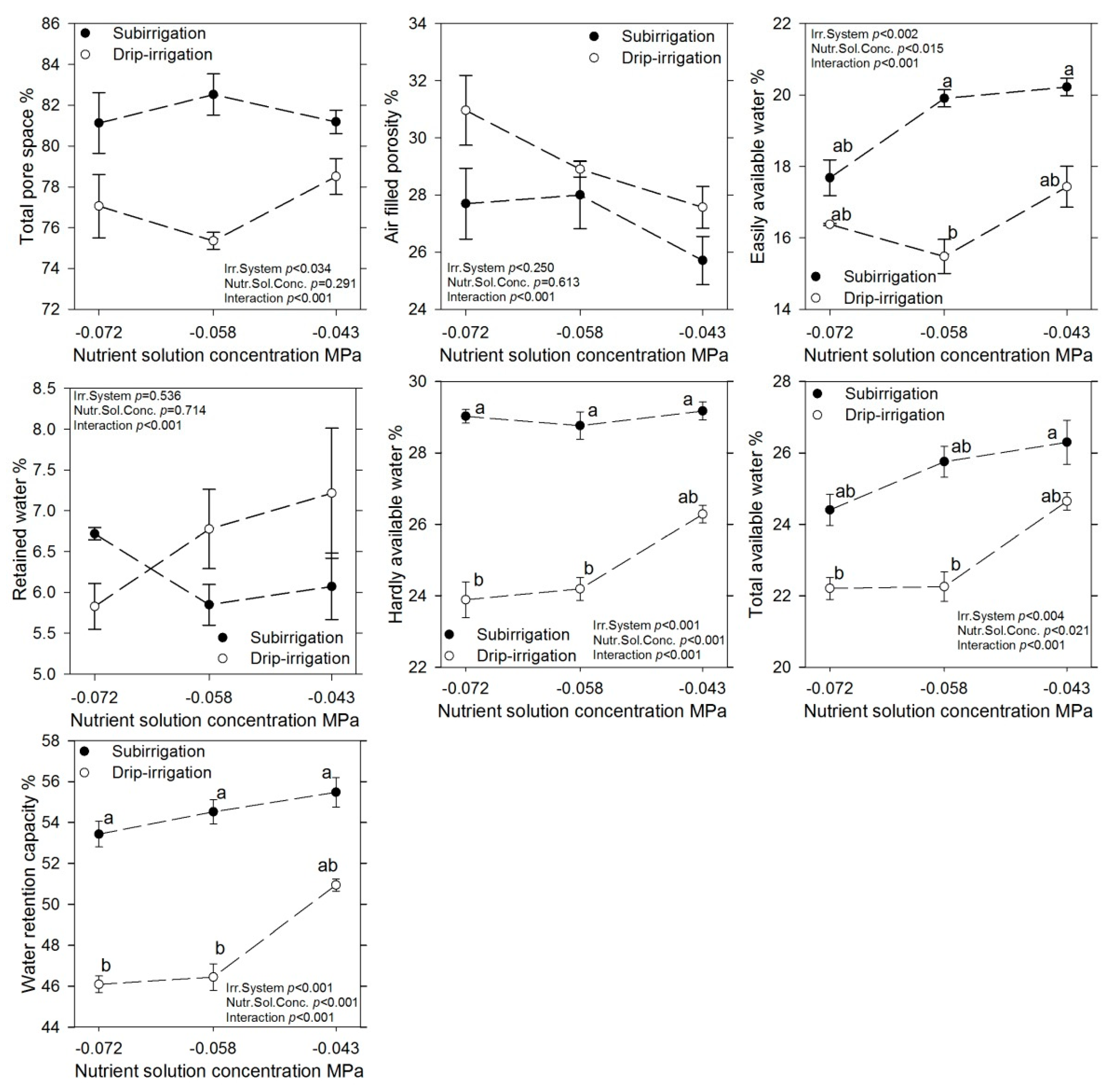
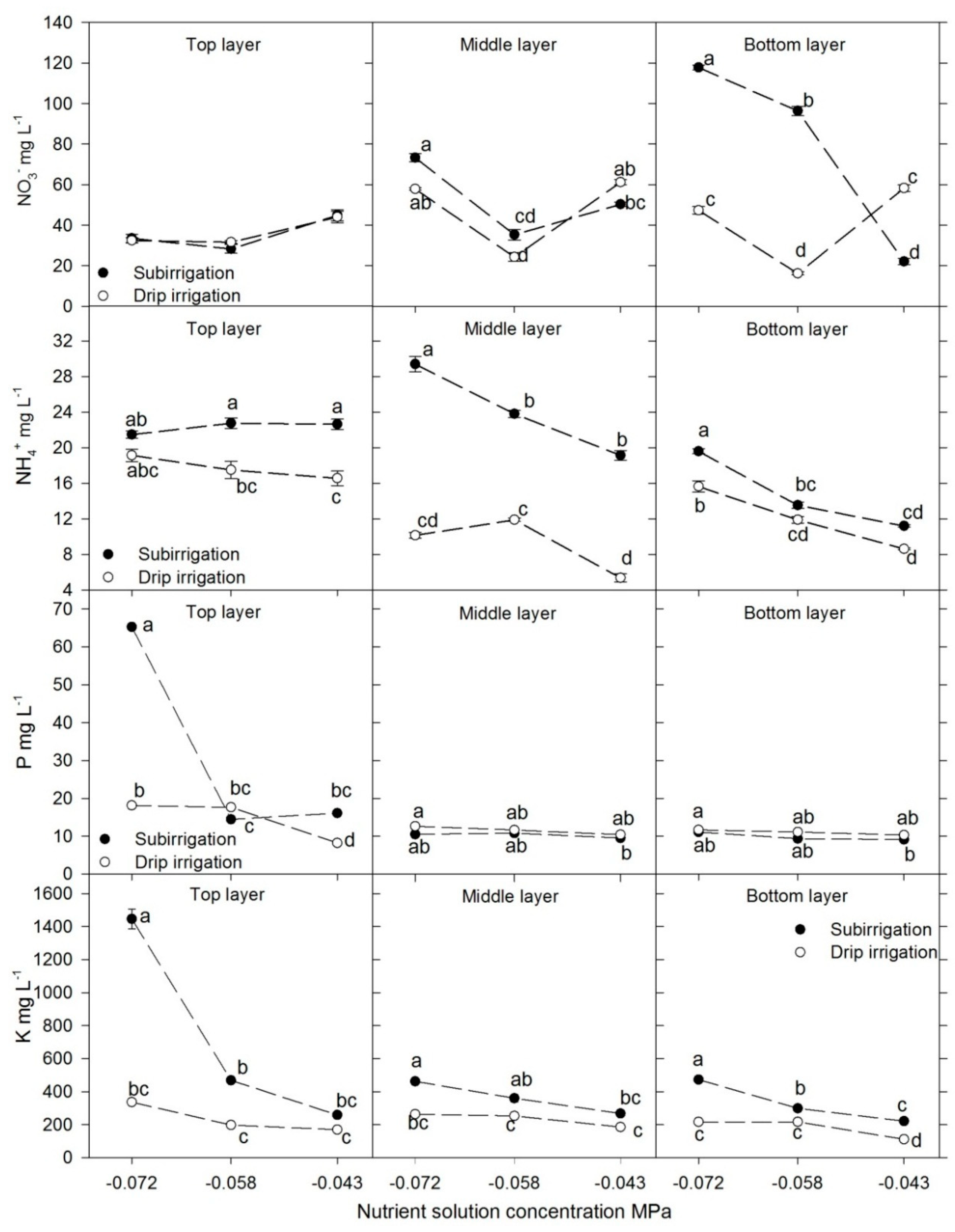

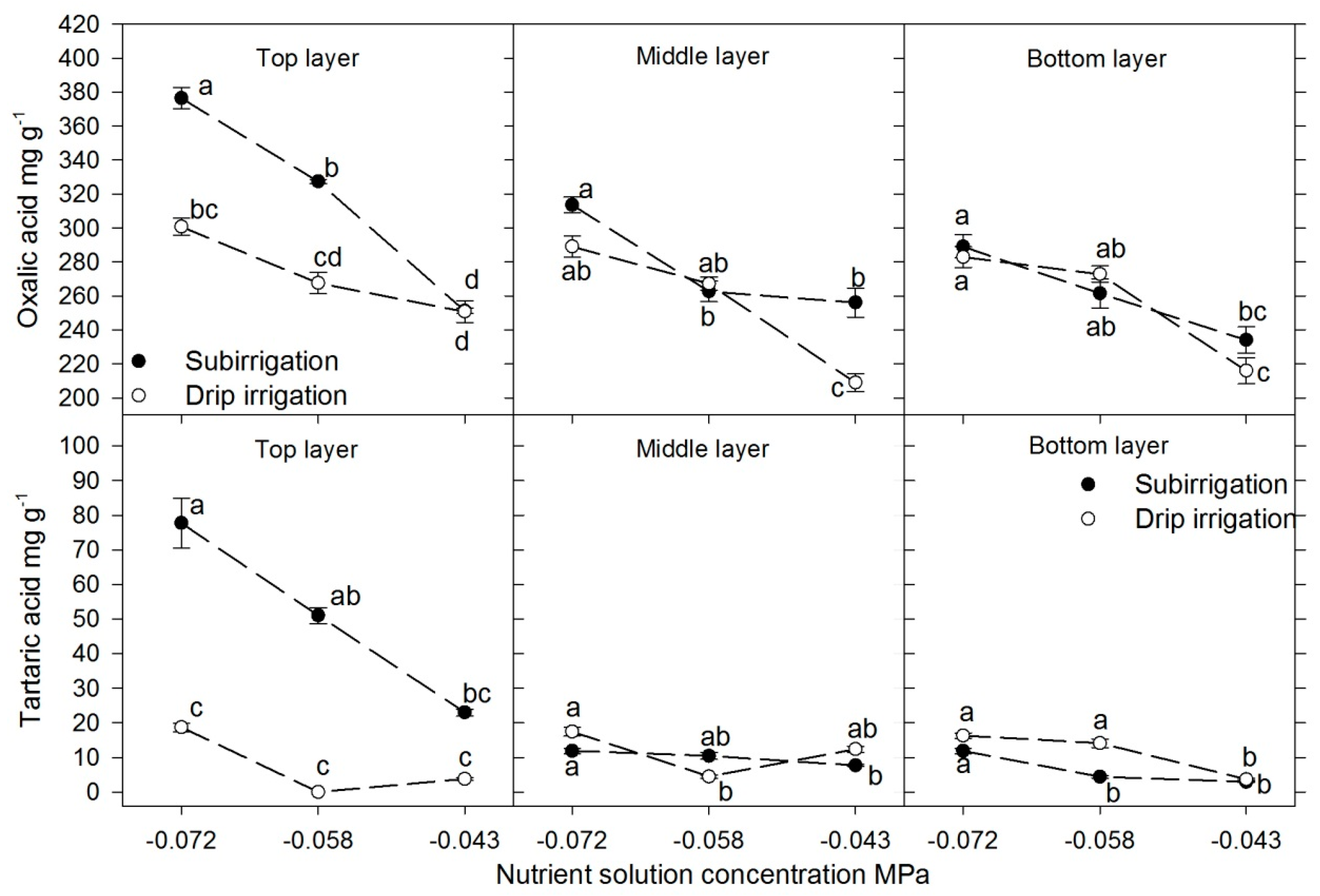
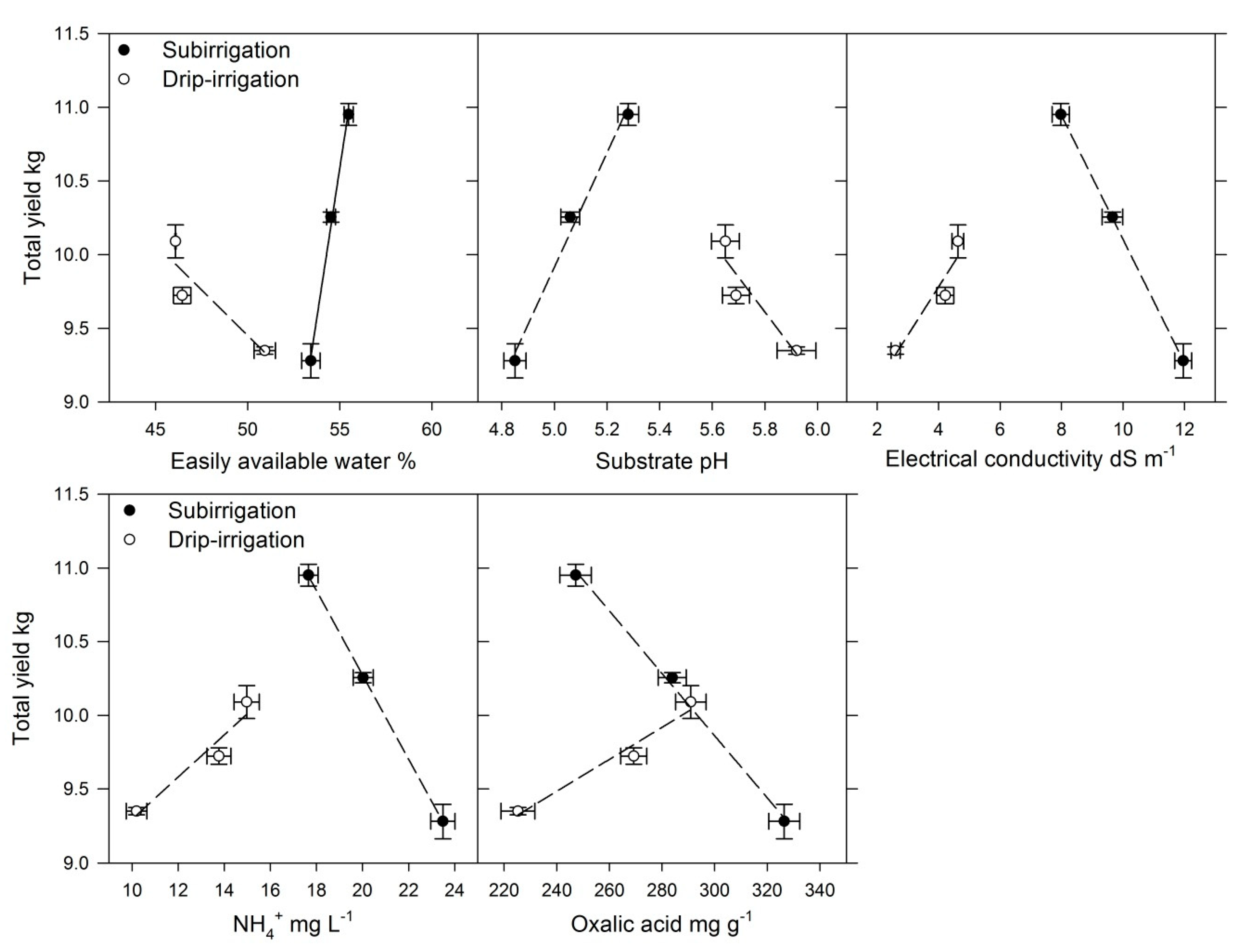
© 2019 by the authors. Licensee MDPI, Basel, Switzerland. This article is an open access article distributed under the terms and conditions of the Creative Commons Attribution (CC BY) license (http://creativecommons.org/licenses/by/4.0/).
Share and Cite
García-Santiago, J.C.; Valdez-Aguilar, L.A.; Cartmill, D.L.; Cartmill, A.D.; Juárez-López, P.; Alvarado-Camarillo, D. Subirrigation of Container-Grown Tomato II: Physical and Chemical Properties of the Growing Medium. Water 2019, 11, 2211. https://doi.org/10.3390/w11112211
García-Santiago JC, Valdez-Aguilar LA, Cartmill DL, Cartmill AD, Juárez-López P, Alvarado-Camarillo D. Subirrigation of Container-Grown Tomato II: Physical and Chemical Properties of the Growing Medium. Water. 2019; 11(11):2211. https://doi.org/10.3390/w11112211
Chicago/Turabian StyleGarcía-Santiago, Juana Cruz, Luis Alonso Valdez-Aguilar, Donita L. Cartmill, Andrew D. Cartmill, Porfirio Juárez-López, and Daniela Alvarado-Camarillo. 2019. "Subirrigation of Container-Grown Tomato II: Physical and Chemical Properties of the Growing Medium" Water 11, no. 11: 2211. https://doi.org/10.3390/w11112211
APA StyleGarcía-Santiago, J. C., Valdez-Aguilar, L. A., Cartmill, D. L., Cartmill, A. D., Juárez-López, P., & Alvarado-Camarillo, D. (2019). Subirrigation of Container-Grown Tomato II: Physical and Chemical Properties of the Growing Medium. Water, 11(11), 2211. https://doi.org/10.3390/w11112211





